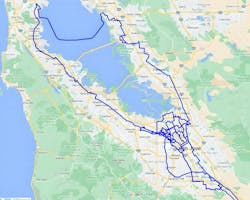Bandwidth IG’s focus on dark fiber is a specialized one, and its move to expand the availability of this asset in the San Francisco Bay Area—a booming data center market—reflects the growing need for dedicated fiber facilities.
Bruce Garrison, CEO of Bandwidth IG, said he sees his company as a fiber infrastructure specialist. Garrison has plenty of experience developing fiber plans for data centers as he spent five years at Zayo, with his last role as Senior Vice President in Zayo’s colocation segment, zColo.
“Bandwidth IG is in a niche part of the market where we build and operate large amounts of dark fiber networks,” he said. “We’re focused on building critical infrastructure for data centers.”
While extending the dark fiber network to area cell towers and large businesses like hospitals would be easy, focusing on just data centers means BandwidthIG can provide the best customer experience.
“We are a data center to data center business, but not to cell towers or every hospital or university,” Garrison said. “This is intentional because it allows lower latency, less splicing and less degradation of services when our customers light the fiber.”
Fast growing market
The need for new fiber options to serve San Francisco’s data center market has never been more pressing.
According to Cushman & Wakefield, the Silicon Valley data center market will remain a top North American market, with cloud and AI contributing to demand. The market has 824MW in operation and another 315MW under construction.
BandwidthIG’s new fiber network creates a high-capacity fiber ring that encloses the northern part of the Bay Area and provides a direct connection from downtown San Francisco to the East Bay.
The provider continues to enhance its dark fiber presence in the San Francisco Bay area. Its latest expansion will deliver over 310 route miles and over 2 million fiber miles to one of the world’s largest data center markets.
With the Bay crossing complete, BandwidthIG is taking the time to celebrate a significant milestone for the provider. “It is a three-year project that included the complexities of permitting with municipalities,” Garrison said. “It was a big project for us, and we started celebrating with the Bay crossing complete.”
Today, Bandwidth IG serves 65 data centers. The provider plans to add more miles throughout this year. Its fiber ring will ultimately connect to all major data centers in the Bay Area, including its recent build into Santa Clara with 75 MW of capacity.
Overall, the Bay Area data center market will continue to scale. “There’s still more expansion to come,” Garrison said. “The Bay Area is the largest premier interconnection on the West Coast and will continue to grow.”
Fresh fiber network
Bandwidth IG’s San Francisco Bay Area network is on net to more than 65 data centers and will reach ten additional facilities upon completion of the expansion. The project is expected to be completed by the second quarter.
“We are putting in infrastructure that did not previously did not exist,” Garrison said. “Because of AI and cloud consumption, there’s a need for more fiber infrastructure.”
One of the issues in the Bay Area was that the infrastructure was outdated and unsuitable to handle new demands from hyperscaler datacenter operators.
“The infrastructure in the ground today is 15-20 years old and has a lower fiber count,” Garrison said. “We’re in the driver’s seat with the hyperscalers that consume the most, so we’re in the forefront of building the infrastructure they need to accommodate AI and other emerging technologies.”
Marine crossing challenges, opportunities
One of the critical elements of the new build is that it includes the first marine cable to be laid in over 20 years under the San Francisco Bay, with a high-capacity fiber ring that will connect Great Oaks and Santa Clara up the East Bay and Peninsula.
This ring ties into downtown San Francisco to create one of the Bay Area’s highest-capacity fiber rings.
Besides providing added capacity to the market, Bandwidth IG’s networks are intentionally placed to provide the most direct route, which reduces latency. To enclose the northern part of the ring and create a natural path for connectivity between San Francisco and the East Bay area, Bandwidth IG constructed one of the only subsea routes under the San Francisco Bay with a high fiber count.
In decades, it’s also the first fiber cable under the Bay to be installed for communications services.
“The Bay crossing was the most complex,” Garrison said. “There is fiber along the bridge attachments, but it does not have the density and capacity needed.”
An essential requirement for BandwidthIG is that the provider needs to complete the build before Nov 1st with a moratorium. The service provider had to work with several state, local and federal agencies.
“It is the largest fiber count cable on the marine floor today,” Garrison said.
Underground installation focus
Unlike legacy fiber networks with lower fiber counts and a mix of aerial and underground, BandwidthIG is focused on all underground construction.
By doing it this way, the dark fiber provider can gain control and provide a consistent experience for its customers.
Bandwidth IG’s Northern California network offers more than 50 route miles and 89,000 fiber miles.
“We did something completely different where it’s all underground, all the same fiber type, and it has fewer splice points,” Garrison said. “The capacity gives a run life of around a few decades to keep adding more fiber count.”
He added, "without this critical infrastructure, these nice shiny data centers would be islands.”
Eying other markets
Outside of the Bay Area, Bandwidth IG is growing in other markets. It also operates dark fiber networks in other key cities, including Greater Portland, Hillsboro, and Greater Atlanta.
Bandwidth IG is present in over 15 Greater Portland and Hillsboro data centers. It has built 34,000 fiber miles and over 20 route miles.
This places it in proximity to several new Pacific Northwest subsea cables. “It’s a good data center market, but geographically, it's a bit more confined,” Garrison said.
In Greater Atlanta, Bandwidth IG has built fiber through the central business district in downtown Atlanta to the emerging data center district in Douglas County. For that market, it provides fiber into over 25 area data centers with over 170 route miles and over 300,000 fiber miles.
According to a Data Center Frontier report, Atlanta has become a hotbed of data center build activity as Northern Virginia's power constraints have risen. Atlanta is also a desirable data center market due to its availability of land and power to accommodate future hyperscaler data center growth.
Besides Meta’s move to build a large data center in Newton County, several data center providers, including Vantage Data Centers, Switch, Flexential, DataBank, and Microsoft, are all at some stage of building out new data centers in the Atlanta area.
“Georgia has a lot of ingredients that will make one of the top data center markets for the next ten years,” Garrison said. “We are up to 200 route miles in Greater Atlanta and will pass 300 in the next 24 months.”
For related articles, visit the Optical Tech Topic Center.
For more information on optical components and suppliers, visit the Lightwave Buyer’s Guide.
To stay abreast of optical communications technology, subscribe to Lightwave’s Enabling Technologies Newsletter.

Sean Buckley
Sean is responsible for establishing and executing the editorial strategies of Lightwave and Broadband Technology Report across their websites, email newsletters, events, and other information products.


